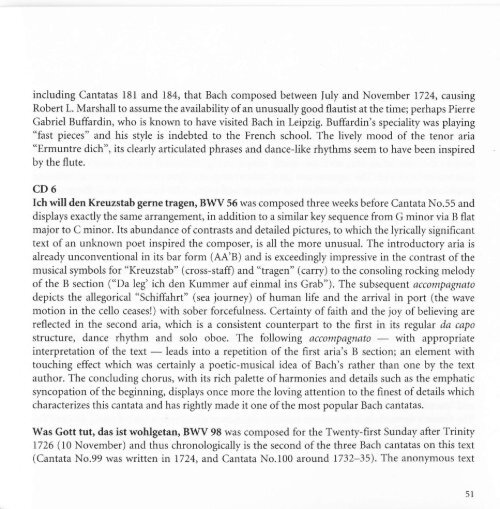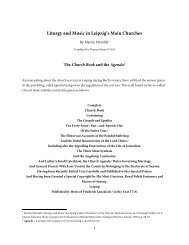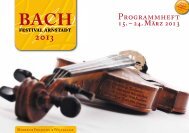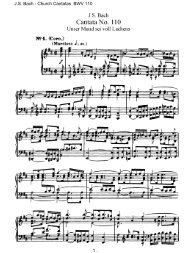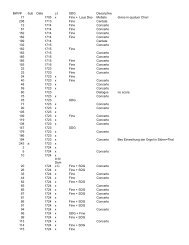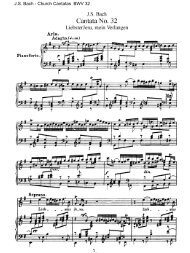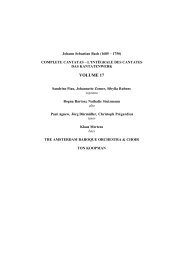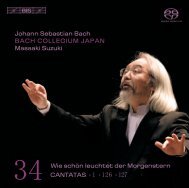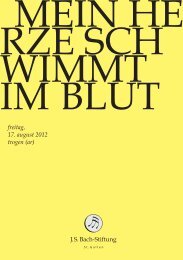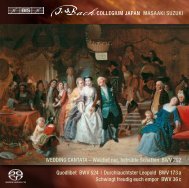Bach Cantatas, Vol. 2 - F. Werner (Erato 10-CD)
Bach Cantatas, Vol. 2 - F. Werner (Erato 10-CD)
Bach Cantatas, Vol. 2 - F. Werner (Erato 10-CD)
You also want an ePaper? Increase the reach of your titles
YUMPU automatically turns print PDFs into web optimized ePapers that Google loves.
including <strong>Cantatas</strong> 181 and 184, that <strong>Bach</strong> composed between fuly and November 1724, causing<br />
Robert L. Marshall to assume the availability of an unusually good flautist at the time; perhaps Pierre<br />
Gabriel Buffardin, who is known to have visited <strong>Bach</strong> in Leipzig. Buffardin's speciality was playing<br />
"fast pieces" and his style is indebted to the French school. The lively mood of the tenor aria<br />
"Ermuntre dich", its clearly articulated phrases and dance-like rhythms seem to have been inspired<br />
by the flute.<br />
<strong>CD</strong>6<br />
Ich will den Kreuzstab gerne tragen, BWV 56 was composed three weeks before Cantata No.55 and<br />
displays exactly the same arrangement, in addition to a similar key sequence from G minor via B flat<br />
major to C minor. Its abundance of contrasts and detailed pictures, to which the lyrically significant<br />
text of an unknown poet inspired the composer, is all the more unusual. The introductory aria is<br />
already unconventional in its bar form (AA'B) and is exceedingly impressive in the contrast of the<br />
musical symbols for "Kreuzstab" (cross-staff) and "tragen" (carry) to the consoling rocking melody<br />
of the B section ("Da leg'ich den Kummer auf einmal ins Grab"). The subsequent accompagnato<br />
depicts the allegorical "Schiffahrt" (sea journey) of human life and the arrival in port (the wave<br />
motion in the cello ceases!) with sober forcefulness. Certainty of faith and the joy of believing are<br />
reflected in the second aria, which is a consistent counterpart to the first in its regular da capo<br />
structure, dance rhythm and solo oboe. The following accompagnato<br />
-<br />
with appropriate<br />
interpretation of the text -<br />
leads into a repetition of the first aria's B section; an element with<br />
touching effect which was certainly a poetic-musical idea of <strong>Bach</strong>'s rather than one by the text<br />
author. The concluding chorus, with its rich palette of harmonies and details such as the emphatic<br />
syncopation of the beginning, displays once more the loving attention to the finest of details which<br />
characterizes this cantata and has rightly made it one of the most popular <strong>Bach</strong> cantatas.<br />
Was Gott tut, das ist wohlgetan, BWV 98 was composed for the Twenty-first Sunday after Trinity<br />
1726 (<strong>10</strong> November) and thus chronologically is the second of the three <strong>Bach</strong> cantatas on this text<br />
(Cantata No.99 was written in 1724, and Cantata No.l00 around 1732-35). The anonymous text


